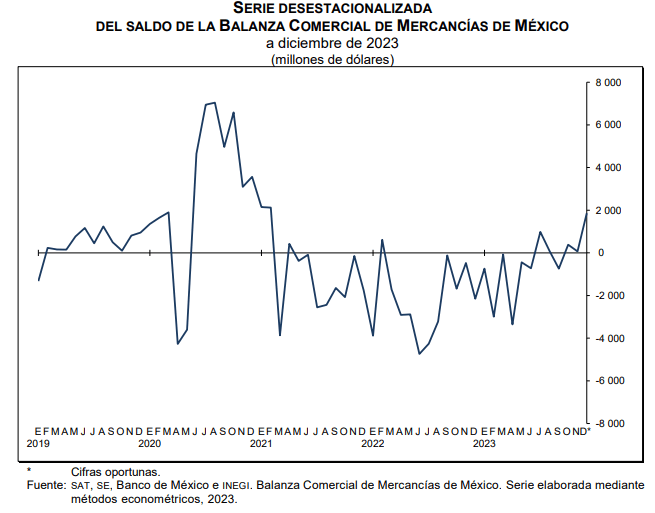During 2023, Mexico‘s product trade balance showed a deficit of US$5.464 billion, which compares with a deficit of US$26.879 billion observed in 2022.
The trade balance is an economic term that refers to the difference between the value of a country’s exports and imports of goods and services during a specific period of time, usually a year.
In terms of product trade, the decrease in the deficit balance between 2022 and 2023 originated from a higher surplus in the balance of non-oil products -which went from 8,263 million dollars, in 2022, to 13,073 million dollars, in 2023- and from a reduction in the deficit of the balance of oil products -which went from 35,142 million dollars in 2022 to 18,536 million dollars, in 2023-.

To take into account: the trade balance can influence a country’s economic health and affect factors such as the currency exchange rate, foreign investment and the accumulation of international reserves.
However, it is important to consider other aspects of the current account, such as flows of services, transfers and capital flows, to get a complete picture of a country’s economic position.
Trade balance
In 2022, Mexico’s current account recorded a deficit of US$13.4 billion, or 0.9% of GDP, compared to a deficit of US$8.2 billion, or 0.6% of GDP, in 2021.
The increase in the current account deficit was mainly due to a higher deficit in the oil trade balance and a lower surplus in the non-oil trade balance, partially offset by higher inflows of remittances and travel-related income.
The current account is one of the main accounts of a country’s balance of payments and represents the systematic recording of all economic transactions that country carries out with the rest of the world in a specific period.
The current account is divided into several sub-accounts, which include:
Balance of trade: this subaccount records transactions in goods and services. If exports exceed imports, there is a trade surplus; otherwise, there is a deficit.
Primary income: includes income flows generated by investments, such as direct investment income and foreign investment earnings.
Secondary income: records money transfers that are not related to the purchase or sale of goods and services. This may include government transfers, remittances and donations.
Balance of services: apart from tangible goods, this sub-account deals with intangible services, such as tourism, transportation, financial services, insurance, among others.

